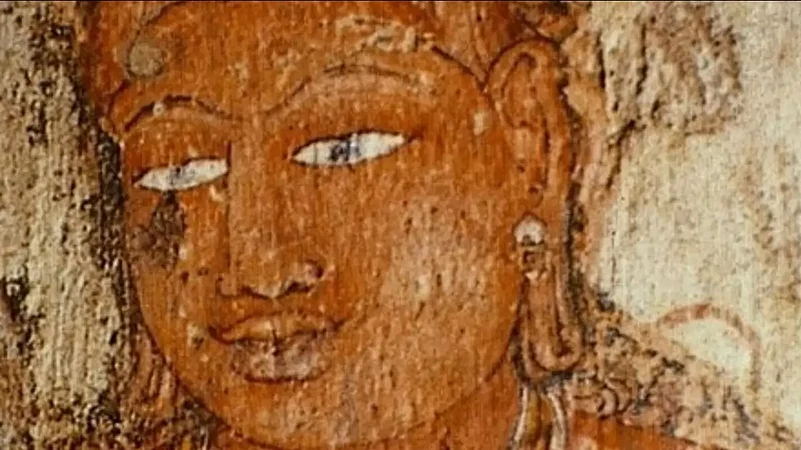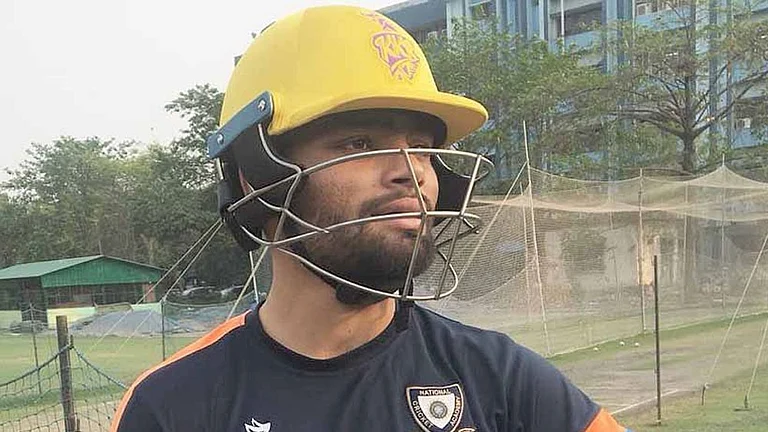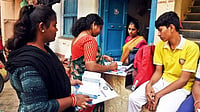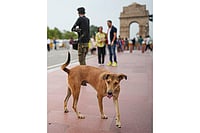Nearly a month after controversy over whether the 10th-century Dravidian ruler Raja Raja Chola was Hindu or not, the Tamil Nadu government has decided to mark November 3, the legendary ruler's birth anniversary, as a state event.
The Dravida Munnetra Kazhagham (DMK) government has announced in an official statement that November 3 shall henceforth be celebrated as an annual state event to mark the birth anniversary of the Chola ruler who recently came back into the limelight after the success of the Mani Ratnam film Ponniyin Selvan: I. The film, featuring Bollywood actress Aishwarya Rai along with Vikram and Trisha Krishnan, is based on a fictionalised account of Raja Raja Chola's life.
Following the release of the film in Tamil, Telugu, Malayalam and Hindi languages, controversy erupted in the first week of October when National Award-winning Tamil director Vetrimaaran, at an event, claimed that the BJP was trying to steal their identity by appropriating Tamil icons. Apparently irked by the depiction of the Chola ruler as a Hindu king in the film, an agitated Vetrimaaran said, "Raja Raja Chola wasn't Hindu but they (BJP) are trying to steal our identity. They have already tried to saffronise Thiruvalluvar. We should never allow that".
The remarks did not sit well with BJP and its leaders doubled down on the claim that Raja Raja Chola was indeed Hindu. "I am not well versed with history like Vetrimaaran, but let him point out two churches and mosques built by Raja Raja Chola. He called himself Sivapadha Sekaran. Wasn't he a Hindu then?" BJP leader H Raja argued.
Vetrimaaran found support from actor-politician Kamal Haasan who also claimed that Raja Raja Chola was not Hindu and in fact, the term "Hindu" did not even exist at the time.
"There was no name called 'Hindu religion' during Raja Raja Chola's period. There was Vainavam, Shivam, and Samanam, and it was the British who coined the term Hindu since they didn’t know how to refer to it collectively. It is similar to how they changed Thuthukudi into Tuticorin," Haasan had said.
Telangana governor Tamilisai Soundararajan joined the chorus and ominously warned against alleged attempts that were being made to conceal the Hindu cultural identity of key personalities in Tamil Nadu.
The comments led to a war of words between BJP and ruling DMK as well.
DMK leader TKS Elangovan cited the reportedly "well documented" conflicts between Shaivite and Vaishnavite rulers of South India to support the claim that Raja Raja Chola was a Shaivite king, not a Hindu king.
"King Hiranya was a Shaivite who had a Vishnu-worshipping son, and Vishnu chose to kill him with his own avatar of Narasimha. The politics used to be different then. There were two different philosophies and they fought each other. They were not one," Elangovan said.
In response, BJP leaders like BL Santosh claimed that Raja Raja Chola was not a Dravidian king at all since there was no Tamil Nadu at the time of his reign. The contesting claims to his legacy today, over a millennium since his death, perhaps shed a glimpse of the importance of the king's contribution to Tamil history.
So who is Raja Raja Chola and was he indeed Hindu?
This is not the first time that Raja Raja Chola has caused controversy in modern-day India. In 2019, Madras High Court quashed a plea against filmmaker Pa Ranjith who had claimed that Raja Raja Chola and other Chola dynasty rulers had oppressed Dalits. The complaint against Pa Ranjith contended that the filmmaker's comments were creating caste-based divisions.
So who really was Raja Raja Chola?
Raja Raja Chola or Rajaraja I was a ruler of the Chola dynasty who reigned form from 985 CE – 1014 CE. Historians describe him as one of the most powerful Tamil kings whose expansionist governance restored the influence of the Chola dynasty in the region by annexing vast swathes of key Pandya strongholds. His reign not only helped the Cholas become an influential force in South India but also across the Indian Ocean with the empire spreading roots to Sri Lanka, Lakhwadweep and parts of the Maldives among other nations. Present-day states like Kerala (named Kandalur Salai at the time) and Karnataka (Tadigaipadi) were also under Raja Raja Chola’s control. He is known to have been a ruthless and skilled conqueror but also renowned for his administrative acumen.
He initiated land survey projects and reorganized his kingdom into smaller constituencies like ‘valanadus’ in what can be viewed as a medieval precursor to contemporary federalism. He vouched for local self-governance and audits and made local bodies such as village-level assemblies autonomous.
History vs Ontology
But what about his religion? Was Raja Raja Chola Hindu? Were the Cholas practicing Hindu kings? The ruler is credited with building the enormous Brihadisvara Temple in Thanjavur dedicated to the worship of Shiva. The temple recently got the UNESCO world heritage tag. Walls of the temple depict murals of the king. This leads many to the claim that the Chola king was a Shiva-worshipping Hindu.
However, Shiva worship or Shaivism predates formal “Hinduism” as it exists now.
The term “Hindus” or “Hinduism” was created by the British who emerged centuries after Raja Raja Chola's reign, which ended in 947 CE. At that time, Hinduism did not exist as a single entity and using Hinduism to describe the oeuvre of religious expressions and movements like Shaivism as "Hindu" might be a misnomer, at least when describing the medieval period. Devotional and monistic Shaivism, for instance, was a prominent religion, even in the 1st millennium CE.
How Shaivism evolved into a foundational structure for Hinduism over the years is a question for another essay but it is safe to say that at the time Raja Raha Chola was practicing it, he identified himself as a devout Saivite (worshipper of Shiva), not a Hindu, with a religious identity the same as modern-day practicing Hindus.
That being said, commentators have argued that though Hindusim did not exist in its formal form at the time, Sanatan Dharam did and Shaivism was part of it. Sanatan Dharam is often referred to not as a religion but as a way of life and is seen as a precursor to Hinduism. Unlike Abrahamic religions like Islam and Christianity, Hinduism is seen by many as an essentially uncodified combination of doctrines and denominations without any set ecclesiastical order or rules.
Some historians feel that attempts to assimilate these religious identities with affinities to contemporary Hinduism under one 'Hindu' umbrella are intended to serve political narratives that pit Indian rulers as "Hindu" as opposed to "Islamic invaders" such as the Mughals. In an interview with The Economic Times, historian Anjana Krishnan said that though they had a tradition of building "pallipadai temples" and followed multifarious Shiva worship cults, the debate around proving them Hindu today is primarily intended at pitting them against Muslim or Mughal rulers in a reductionist attempt to divide India's chequered and complex religious history into neat blacks and white (read Hindu Muslim) boxes.
Speaking to The Quint, historians like Richard H Davis from New York’s Bard College of Annandale-on-Hudson confirmed that there was neither the idea of a single, unified religion uniting various “groups or communities that worshiped Shiva, Vishnu, the goddess, and other deities” at the time of Raja Raja Chola and that such a classification was a much later evolution. Davis also clarified that while building the Shiva temple, Raja Raja Chola was more likely to have considered himself a Shiva worshipper under Shaivism rather than Shiva worshipper under Hinduism.
So was Raja Raja Chola Hindu? The question thus becomes not just a matter of history but of ontology. Of what is and isn't Hindu. Of what is and isn't. If Raja Raja is not Hindu since Hinduism did not exist in its current shape and form at the time, then is BJP's BL Santosh right in claiming he isn't Dravidian either since Tamil Nadu also did not exist in its current form?
Is Shaivism part of Hinduism ?
One of the oldest thought experiments in the world is the idea of the ‘Ship of Theseus’. The puzzle ponders over the idea of identity over time with a simple question - does a ship, whose parts have been replaced over time, remain the same ship? Is it the original ship with new parts or a new ship made out of the old parts?
The answer to whether Shaivism is part of Hinduism is kind of like that.
Shaivism refers to the organized worship of Shiva. Shaivism, along with Vaishnavism (worship of Vishnu) and Shaktism (worship of the divine goddess), constitute the three principal pillars of modern Hinduism.
Evidence of Shiva worship, however, dates back to the pre-historic times during the Harappan civilization and pre-dates Dravidian, Aryan or Vedic understanding of religion. Though he is mentioned in all the Vedas, his first mention is found in the Rig Veda in the form of Rudra, one of Shiva’s three central incarnations in early Shaivism (Nataraja, Rudra, Linga). The foundational tenets of Shaivism, however, can be found in the Svetasvatara Upanishad, which is usually considered the equivalent to the Bhagavad Gita revered by Vaishnavites and also believed to have been written before it. It contained the key terminology of Shaivism and conceptually introduced Shiva, Rudra, Maheswara, Guru, Bhakti, Yoga, Atman, Brahman and self-knowledge. After rising in popularity through 700-1000 CE, Shiva worship or Shaivism became one of the biggest religions of South India.
Claiming Shiva
Whether Shaivism is a part of or the same as Hinduism or not is not just a question of religious faith but also a matter of political import. With the BJP trying to project itself as the custodian of the Hindu faith and identity in the country, there have been concerted efforts to appropriate all Hindu denominations under a singular Hindu identity, much like the British had done back in the 17th and 18th century when the terms Hindus and Hinduism first came in vogue. It was also the time for the shaping of a "Hindu" identity as opposed to the Christians and the Muslims.
In the 20th century, Vaishnavite Hindu deities played centre stage with issues like Ram Janmabhoomi becoming major political flashpoints. Since the late 80s, there have also been consistent efforts to unify the "Hindutva" worldview to the outlook of all Hindus including those who follow sects or traditions like Shaivism (which contain subgroups like Lingayats and Virashaivas among others, each with their own distinct and sometimes disparate traditions and rituals from Hinduism).
Prime Minister Narendra Modi has been at the forefront of BJP's Shiva-wooing strategies right from his time as Chief Minister of Gujarat when he jumpstarted the restoration and repair work of the historic Somnath temple. Over the past eight years as PM, Modi has invested in several temple construction, revival, and restoration projects including the most recent revamping of Kashi Vishwanath temple, plans to redevelop the Kedarnath temple complex, and launching of the Mahakal Corridor in Madhya Pradesh's Ujjain to develop the Mahakaleshwar temple complex. In 2017, he unveiled a 112-foot tall face of Lord Shiva or 'Adhiyogi' at Isha Foundation near Coimbatore to mark Shiv Ratri.
Critics and observers alike have agreed that in Lord Rama and Ramayana, the BJP found a pan-India symbol to be forged as an icon. However, Rama's pull in South Indian states like Tamil Nadu remains contested by Shaivite philosophy. In Shiva, the BJP may have an opportunity to gather and unify both north and south under the religious denomination of Hindu Shiva worship.
Thus the DMK government's decision to celebrate Raja Raja Chola's birthday may reflect more than just political opportunism but deeper foresight and understanding. It means the DMK is aware of the BJP's tactics and is one step ahead.
In a statement, TN CM MK Stalin said that Raja Raja Chola’s birth anniversary has always been celebrated in the state as Sadhaya Vizha by several organisations in Thanjavur district. However, after “demands from various quarters”, the emperor’s birth anniversary will be celebrated as a government function from this year onwards. In the statement announcing the celebration, MK Stalin also promised that the memorial dedicated to Raja Raja Chola will soon be renovated and embellished. Clearly, Stalin realises that political symbolism is a two-way street, and in politics, visibility and optics matter.
Irrespective of whether Raja Raja Chola was Hindu or not, DMK has won this round.


























